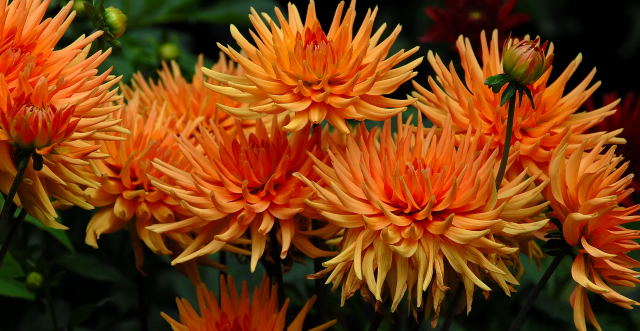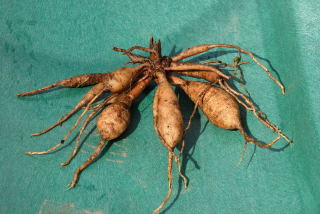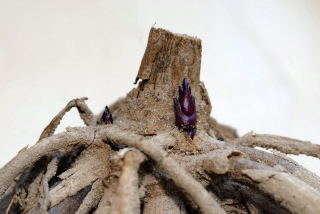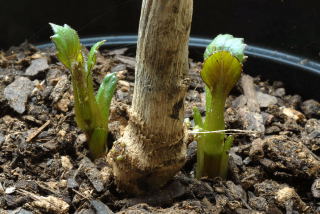Growing Dahlias

Growing dahlias must be one of horticultural world's least challenging tasks. They are often derided, a particular fault seems to be that they are just too easy to grow. Admittedly, a single plant, tied to bamboo cane as if awaiting the firing squad, does not look all that impressive. However, give them a rich, moist soil and plenty of sun and they wont let you down.
There are a huge variety to chose from. Tall ones, short ones, fat ones , thin ones (as the story goes) and 11 different classifications of flower shape. For the purposes of the cool tropical garden, avoid varieties with a flower shape described as Pompon or Ball, these tend to look rather too manufactured.
Acquiring Dahlias
Dahlias can be purchased either as seeds, dormant tubers or as a growing plant.
- Buying seeds. The trouble with growing dahlias from seed is that you can't guarantee the dahlia flowers' colour. Seeds are generally sold in packets containing 'mixed colours'. If you are not bothered about colours, then this is fine, but if you want a specific colour, you will need to grow the plants one year, select the plants you want and then grow them on for next years scheme.
- Dormant tubers. This is a cheap and easy method of growing dahlias. They are easy to get into growth and easy to take cuttings from. You can also control when your plants come into growth. A decent range is available from most garden centres in the spring and mail order companies offer even more choice.
- Growing plants. A pot grown plant is a little more expensive than a dormant tuber and they tend not to be available all that early in the season. These are often sought by people hoping to fill any awkward late summer gaps in their borders. Some dwarf varieties are available along with the general melange of bedding pants but again these are likely to be of mixed colours. if you are after something very specific and the tubers prove elusive, there are many commercial growers who offer the choice of hundreds of varieties. These need to be ordered in advance. The growers will take cuttings in spring and then send the plants on to you once the cuttings have rooted.
So in summary, unless you want something very specific, growing dahlias from dormant tubers is the easiest and cheapest way forward.
Getting your tubers into growth

Dahlia tuber
Getting your tubers into growth is very straight forwards. However once growing a Dahlia will grow quite quickly, so it is important not to start them off too early. A dahlia started in February will be in flower by May. The plant will also be quite tall, taking up valuable space in the greenhouse. This makes the whole process of relocating your plants into the garden from the greenhouse quite hazardous. Tall stems are easily snapped in transit and will require immediate staking once planted.
.

New buds emerging from a tuber
A better time to start off your dahlia tubers is around the Easter holiday period. Dahlia tubers will begin growing when things warm up, so it is important that if you buy tubers in late winter that you store them some where cool to prevent them growing too soon.
When you are ready to start, find a pot big enough to fit the tuber. Half fill the pot with fresh potting compost, add the tuber and cover with compost. The important thing is not to water at this stage. The tubers can rot if over watered at this stage.
.

New shoots poking through the compost
The pot containing the tuber can be left to its own devices (indoors or in the greenhouse) where it will grow when ready. More precise control can be gained by placing the pots on a heated propagation mat.
Once the plant begins to produce shoots, it is safe to begin watering. Use small amounts of water to begin with.
Do not feed the plants or they will grow too fast, attract aphids plus lack sturdiness when planted out in the garden.
Planting out your Dahlias
Dahlias enjoy a position in full sun in a well prepared soil. Mix plenty of home made compost or manure into the planting hole. Plant them about 8 inches apart (20cms) and water them well. You can plant them in mass plantings but they are probably better used as ascents of colour around the garden.
Dahlias grow fast and soon become unstable. Heavy rains make large plants top heavy causing them to fall over. Strong winds do what strong winds always do. So it is important to stake your dahlias to avoid any unnecessary pain on your behalf. Unfortunately dahlias have the tendency to fall over the day before you planned to stake them. Stake them as you plant them!
It is much easier to stake a young plant than to try and untangle half a dozen plants that have collapsed in a heap. Not only is it awkward, but dahlias that have collapsed and been left unattended for even a few days, will have bent upwards towards the light. Then when you stand them up, the tops will be pointing sideways.
Although staking Dahlias when small can look a little untidy initially, the plants will soon cover up any evidence. Plants can be individually tied to a bamboo stake hammered into the ground or can be supported by link stakes.
Pests and diseases
Aphids can be a nuisance inside the greenhouse but hover flies and ladybirds will soon get rid of these once planted in the garden.
A greater threat is posed by slugs and snails. If left unchecked, slugs and snails can soon make a mess of your plants. A single slug is capable of felling an entire stem with a few bites. It is important to make regular night patrols around newly planted dahlias to catch any slugs or snails. Day time observations will help to identify any plants under threat. Return to these plants in the evening and deal with the offenders. Slugs tend to return to the same plant night after night, making it easy for you to round them up. However this habit also means that a neglected plant can soon be badly damaged.
Copper slug rings are effective at keeping slugs off the plants when small.
Earwigs can be a problem for dahlia flowers, often eating the petals. The solution to this problem is to hammer a bamboo stake into the ground so that the top of the stake is at the same level as the endangered flowers. On top of this stake, place and upturned (3-4 inch) plastic flower pot that has been stuffed with straw. The theory is that the earwigs will migrate into the flower pot at dawn. The flower pots containing straw and earwigs can be removed and the contents disposed of.
Mildew can affect the appearance of your plants towards the end of summer. This is usually caused by having damp foliage but dryness at the roots.
More information on Dahlia growing can be found here:

